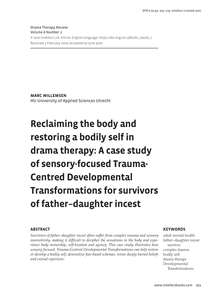In this whitepaper (available in Dutch and English) some practical tips for sensory and consumer research during product development are provided.
MULTIFILE

Virtual reality offers a both realistic and controlled research environment. That is why VR is the future for carrying out valid and reliable research in the social sciences.
MULTIFILE
Given that it is essential for hotels to understand how guests experience hospitality, hotel managers need more concrete and tangible insights into this issue to improve their service. Quantitative research on experience of the physical environment and employee contact has shown that the comfort of hotel rooms and an inviting ambience are the factors that most influence guest loyalty. This exploratory paper employs verbal and visual association methods to translate comfortable and inviting into tangible sensory characteristics. Results show association of comfortable with lingering, sitting, resting, natural colours, rounded-off rectangles, and multiple layers. By contrast, inviting is associated with common (meeting) areas such as corridors, white, grey, transparency, and colourful accessories. Visual dataproved suitable for identifying tangible (sensory) characteristics, and delivering concrete recommendations for improving invitingness and comfort.
MULTIFILE

The aim is to investigate what (tangible) characteristics of the environment people associate with cleanliness, to determine what aspects - apart from technical cleanliness - are involved when people perceive their (working) environment to be 'clean '.
MULTIFILE

People tend to use the same door every time they enter and exit a building. When certainentrances are widely preferred over others, congestion can occur. This paper describes twointerventions to persuade visitors to use another entrance. The first intervention used sensory deprivation (darkness), and the second used guidance paths. The first intervention on sensory deprivation had the expected outcome. This intervention resulted in an avoidance of the darkened door. The second intervention had a result contrary to the expectations; it resulted in an increased preference for the door without guidance paths.
MULTIFILE

Survivors of father–daughter incest often suffer from complex trauma and sensory insensitivity, making it difficult to decipher the sensations in the body and experience body ownership, self-location and agency. This case study illustrates how sensory focused, Trauma-Centred Developmental Transformations can help restore or develop a bodily self, desensitize fear-based schemas, revise deeply buried beliefs and extend repertoire.
DOCUMENT

A previous review concluded that postural sway is increased in patients with low back pain (LBP). However, more detailed analysis of the literature shows that postural deficit may be dependent on experimental conditions in which patients with LBP have been assessed. The research question to be answered in this review was: " Is there any difference in postural sway between subjects with and without LBP across several sensory manipulation conditions?" A literature search in Pubmed, Scopus, Embase and PsychInfo was performed followed by hand search and contact with authors. Studies investigating postural sway during bipedal stance without applying external forces in patients with specific and non-specific LBP compared to healthy controls were included. Twenty three articles fulfilled the eligibility criteria. Most studies reported an increased postural sway in LBP, or no effect of LBP on postural sway. In a minority of studies, a decreased sway was found in LBP patients. There were no systematic differences between studies finding an effect and those reporting no effect of LBP. The proportion of studies finding between-group differences did not increase with increased complexity of sensory manipulations. Potential factors that may have caused inconsistencies in the literature are discussed in this systematic review.
LINK
This pilot study explores the possibility of cognitive training software Neurotracker (NT), to have potential beneficial effects for Traumatic Brain Injury patients with Sensory Processing Disorder. Five subjects with TBI and SPD trained for 5 weeks/21 sessions with Neurotracker. Pre-post training cognitive tests (WAIS TMTA, TMTB, LNS) and surveys were conducted to measure possible cognitive differences with no statistical significant results. However, significant improvement in Neurotracker scores were found. =2.73, SD = 0.55) and positive changes associated with attention attention span, divided attention, (multiple) object tracking and motion sickness. LinkedIn: https://www.linkedin.com/in/bernard-de-roosz-28b96b125/
DOCUMENT

The aim of this study is to unpack the value of ethnographic research as a relevant methodology for studying and developing new business models. A pop-up store we ran for three months in 2020 served as a testlab to experiment with value creation around buying, swapping and borrowing secondhand clothing. LinkedIn: https://www.linkedin.com/in/kim-aplonia-poldner-a003473/ https://www.linkedin.com/in/overdiek12345/
DOCUMENT

This article seeks to contribute to the literature on circular business model innovation in fashion retail. Our research question is which ‘model’—or combination of models—would be ideal as a business case crafting multiple value creation in small fashion retail. We focus on a qualitative, single in-depth case study—pop-up store KLEER—that we operated for a duration of three months in the Autumn of 2020. The shop served as a ‘testlab’ for action research to experiment with different business models around buying, swapping, and borrowing second-hand clothing. Adopting the Business Model Template (BMT) as a conceptual lens, we undertook a sensory ethnography which led to disclose three key strategies for circular business model innovation in fashion retail: Fashion-as-a-Service (F-a-a-S) instead of Product-as-a-Service (P-a-a-S) (1), Place-based value proposition (2) and Community as co-creator (3). Drawing on these findings, we reflect on ethnography in the context of a real pop-up store as methodological approach for business model experimentation. As a practical implication, we propose a tailor-made BMT for sustainable SME fashion retailers. Poldner K, Overdiek A, Evangelista A. Fashion-as-a-Service: Circular Business Model Innovation in Retail. Sustainability. 2022; 14(20):13273. https://doi.org/10.3390/su142013273
DOCUMENT
